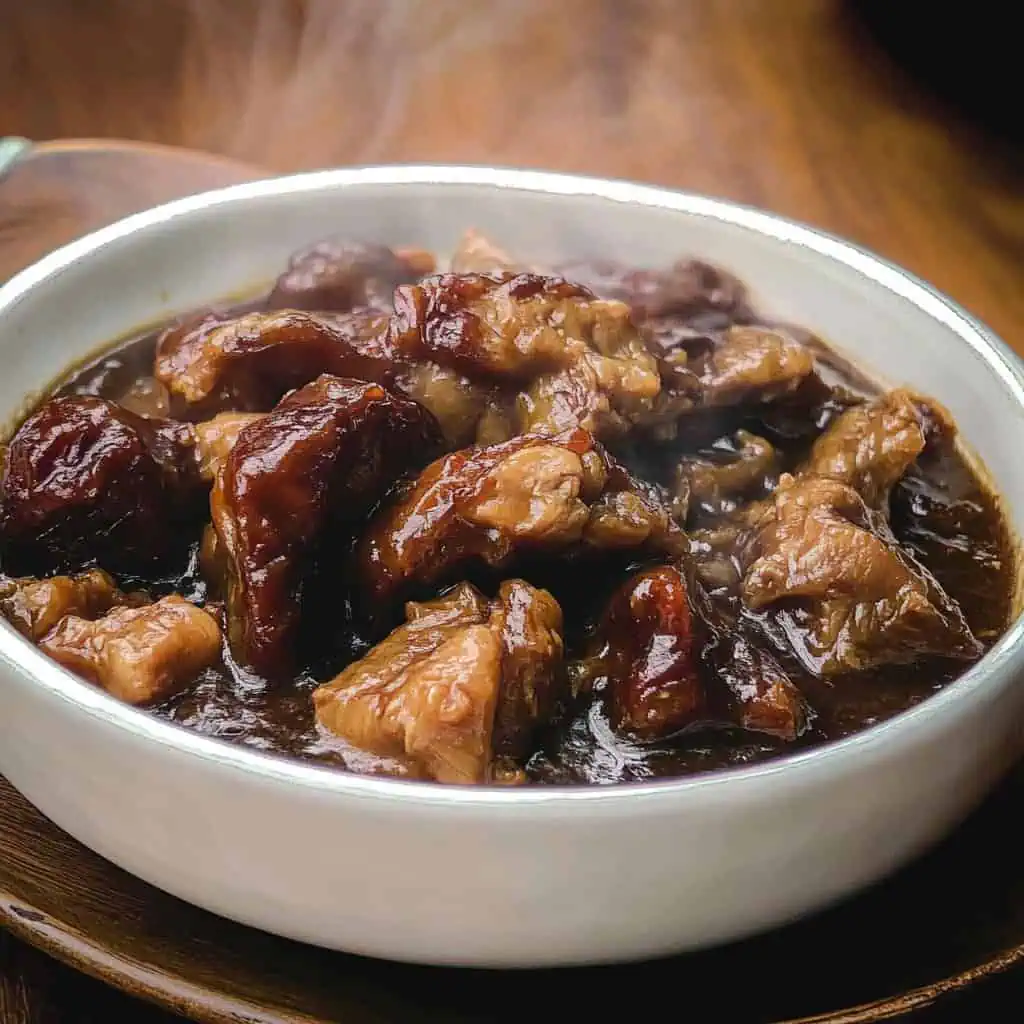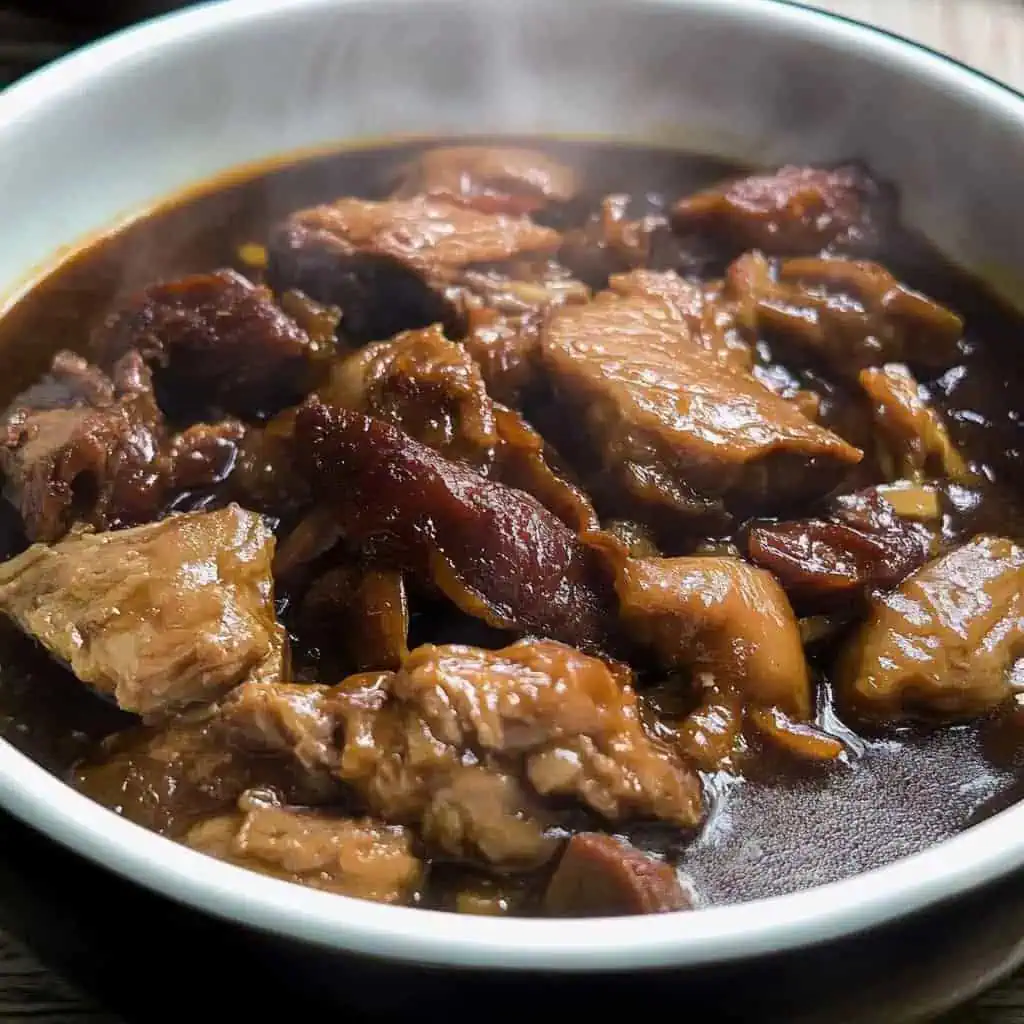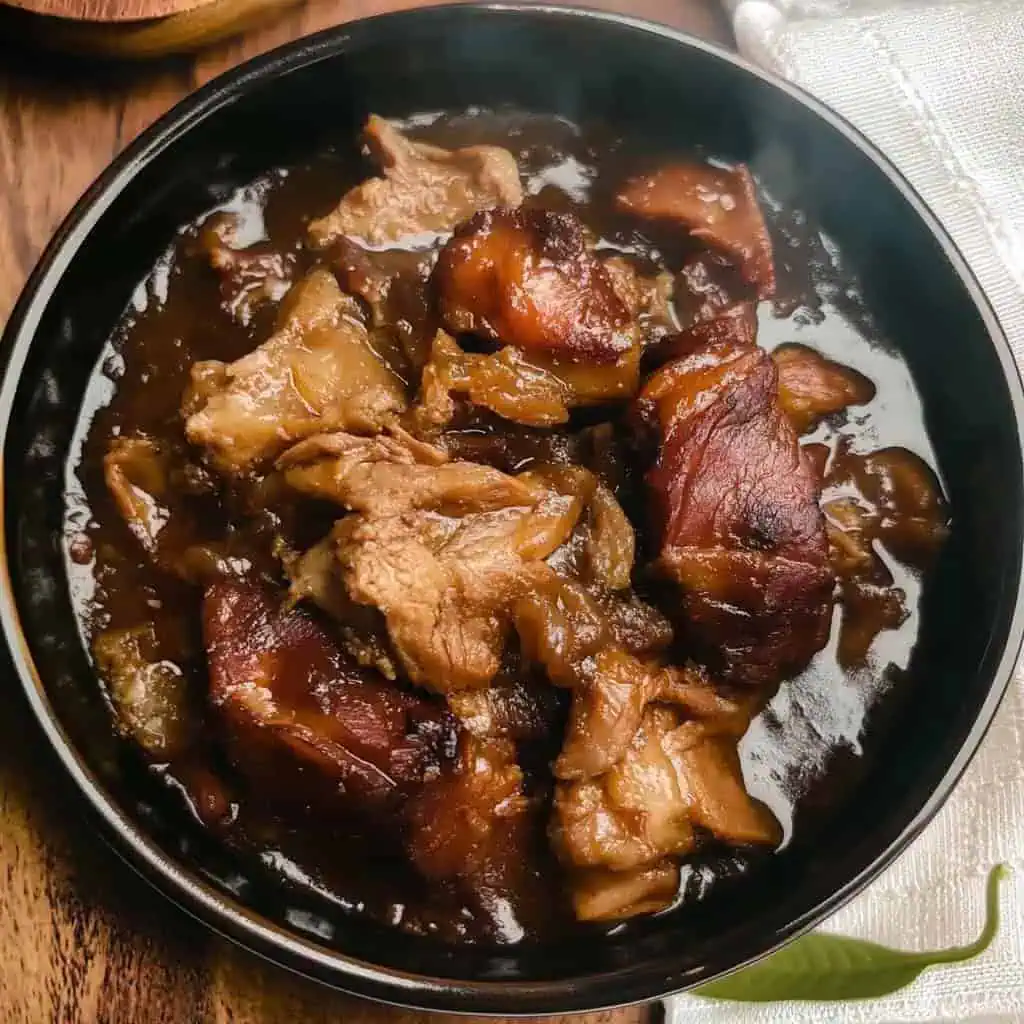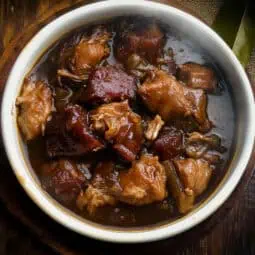The day after Noche Buena was always as exciting as Christmas itself, because that meant my Tito Greg would transform our leftover lechon into his famous lechon paksiw.
I can still picture him in our family kitchen, sleeves rolled up, patiently stirring the pot as the aroma of vinegar, garlic, and liver sauce filled our home.
This recipe isn't just about preventing food waste , it's about creating something entirely new and, dare I say, even more delicious than the original lechon.
Over the years, I've perfected my own version of Tito Greg's recipe, making sure to capture that perfect balance of sweetness and tang that makes lechon paksiw so irresistible.
Jump to:

Why You'll Love This Recipe
- Reduces food waste by transforming leftover lechon into a new, exciting dish
- Perfect balance of sweet, tangy, and savory flavors
- Rich, velvety sauce that's perfect with steamed rice
- One-pot meal that's easy to prepare
- Can be made ahead for busy weekdays
- Authentic Filipino comfort food passed down through generations
Ingredients
This carefully balanced mix creates the signature lechon paksiw flavor. The vinegar preserves and tenderizes the meat while adding tanginess. Liver spread and lechon sauce provide rich depth, while brown sugar balances the acidity.
Aromatics like garlic, onion, and bay leaves infuse the sauce with warmth and complexity, resulting in the perfect sweet-sour profile that Filipinos love.

- 3 pounds (about 4 cups) leftover lechon or lechon kawali, chopped into 1-inch pieces
- 1 tablespoon cooking oil
- 1 large onion, peeled and thinly sliced
- 1 whole head garlic, peeled and minced
- ¾ cup vinegar (preferably cane vinegar)
- 2 cups water
- 2 cups lechon sauce
- ¾ cup brown sugar
- 3 bay leaves
- ½ cup liver spread (such as Reno Brand)
- Salt and pepper to taste
Equipment
- Large heavy-bottomed pot (kaldero) - Provides even heat distribution and prevents burning of the sauce
- Sharp knife (kutsilyo) - For chopping leftover lechon into bite-sized pieces
- Wooden spoon (sandok na kahoy) - For gentle stirring without scratching the pot's surface
- Measuring cups and spoons - For precise measurements of ingredients
- Cutting board - For preparation work and chopping

How To Make
- Heat oil in your pot over medium heat. Add the sliced onions and cook until translucent, about 3-4 minutes. Add minced garlic and cook for another minute until fragrant.
- Pour in the vinegar and water, then bring to a boil. Important: Do not stir immediately! Let it boil for 3-5 minutes to mellow the vinegar's acidity.
- Add the lechon sauce and brown sugar. Stir gently until all the sugar dissolves. Add your chopped leftover lechon and bay leaves, then reduce heat to low. Cover and simmer.
- Cook for about 15-20 minutes, checking occasionally to ensure the meat is becoming tender. If the sauce becomes too thick, add water in ½ cup increments.
- Incorporate the liver spread by stirring well into the sauce. This enriches the flavor and deepens the color. Season with salt and pepper to taste.
- Simmer for another 5-10 minutes until the sauce thickens to a consistency that coats the back of a spoon. Turn off the heat and let rest for 5 minutes.
- Serve hot with steamed rice. The dish should have a perfect balance of sweet and sour flavors, with meat so tender it easily breaks apart with a fork.

Tips from Lola's Kitchen
- Never stir vinegar immediately after adding it to the pot to prevent a metallic taste
- Use a wooden spoon for stirring to maintain the authentic flavor profile
- Simmer on low heat throughout the cooking process for the most tender meat
- Taste before adding salt as lechon sauce already contains sodium
- Let the sauce rest for 5-10 minutes before serving to allow flavors to meld perfectly
- The sauce should thicken naturally through reduction—resist the urge to add thickeners
Substitutions
- Leftover Lechon: No leftover lechon? Use lechon kawali, crispy pata, or even roasted pork belly with crackling
- Liver Spread: Make your own by blending sautéed chicken livers with butter and seasonings
- Lechon Sauce: Use Mang Tomas, or make homemade with liver, bread crumbs, vinegar, and spices
- Brown Sugar: Muscovado sugar adds a deeper molasses flavor, or use palm sugar for an authentic twist
- Cane Vinegar: White vinegar works in a pinch, but apple cider vinegar is a better alternative
- Bay Leaves: Dried thyme can substitute but use half the amount
Troubleshooting
- Sauce too sour: Add brown sugar in one-tablespoon increments until balanced
- Sauce too thin: Simmer uncovered for longer to reduce and concentrate flavors
- Meat tough: Lower heat and extend simmering time by 10-15 minutes
- Sauce too thick: Add water in small amounts (¼ cup) while stirring gently
- Metallic taste: This happens when vinegar is stirred too soon—next time, let it boil before stirring
- Greasy surface: Skim excess fat with a spoon or cool slightly and remove solidified fat
Storage & Reheating
- Refrigeration: Store in an airtight container for up to 4 days—flavors actually improve overnight!
- Freezing: Freeze in portion-sized containers for up to 3 months
- Reheating: Warm slowly in a pot over medium-low heat until internal temperature reaches 165°F
- Revitalizing: Add a splash of water when reheating if sauce has thickened too much
- One-time rule: For food safety, only reheat leftovers once, then discard any remaining portions

FAQ
Can I make lechon paksiw without leftover lechon?
Yes! Use fresh pork belly, but first crisp it up in oil until golden brown to simulate the roasted flavor of lechon.
How do I know when my lechon paksiw is done?
The meat should be fork-tender and the sauce should coat the back of a spoon without running off quickly.
Can I reduce the sugar for a less sweet version?
Absolutely. Start with half the amount and adjust to taste, but maintain some sweetness to balance the vinegar.
Why did my sauce separate or curdle?
This typically happens when vinegar is stirred too early. Always let vinegar boil before stirring, and simmer gently.
Can I add vegetables to make it a complete meal?
Yes! Traditional additions include banana hearts or eggplants added in the last 10 minutes of cooking.
Is this dish gluten-free?
Check your liver spread and lechon sauce ingredients—some commercial brands contain wheat. Otherwise, the dish is naturally gluten-free.
How can I make a spicier version?
Add bird's eye chilies (siling labuyo) either whole or chopped depending on your heat preference.
Can I use an Instant Pot or slow cooker?
Yes! For Instant Pot, use the sauté function for the first steps, then pressure cook for 15 minutes. For slow cooker, cook on low for 4-6 hours.
Related
Looking for other recipes like this? Try these:

Paksiw na Lechon (Filipino Leftover Roast Pork Stew)
Equipment
- Large heavy-bottomed pot (kaldero) For even heat distribution and preventing burning
- Sharp knife (kutsilyo) For chopping leftover lechon
- Wooden spoon (sandok na kahoy) For gentle stirring without scratching the pot
- Measuring cups and spoons (Panukat) For precise measurements
- Cutting board (Sangkalan) For preparation work
Ingredients
For the Meat Base
- 3 pounds about 4 cups leftover lechon or lechon kawali, chopped into 1-inch pieces
- Tagalog: lechon na hiniwa ng 1 pulgada ang laki
For the Sauce
- 1 tablespoon cooking oil
- 1 large onion peeled and thinly sliced (sibuyas na hiniwa ng manipis)
- 1 whole head garlic peeled and minced (isang ulo ng bawang, dinurog)
- ¾ cup vinegar suka
- 2 cups water tubig
- 2 cups lechon sauce sarsa ng lechon
- ¾ cup brown sugar asukal na pula
- 3 bay leaves dahon ng laurel
- ½ cup liver spread liver spread
- Salt and pepper to taste asin at paminta
Instructions
- First, heat oil in your pot over medium heat. Add the sliced onions and cook until they turn clear, around 3-4 minutes. Add minced garlic and cook for another minute until you can smell its aroma.
- Pour in the vinegar and water, then let it come to a boil. Important: Don't stir yet! Let it boil for 3-5 minutes to make the vinegar taste milder.
- After the vinegar has boiled, add the lechon sauce and brown sugar. Stir gently until all the sugar dissolves. Add your chopped leftover lechon and bay leaves, then lower the heat. Cover your pot and let everything cook slowly.
- Cook for about 15-20 minutes, checking now and then to see if the meat is getting tender. If you notice the sauce getting too thick, add a little water, about half a cup at a time.
- Now add the liver spread and stir it in well. This gives your paksiw its rich flavor and color. Add salt and pepper to taste.
- Let everything simmer for another 5-10 minutes until the sauce thickens nicely. You'll know it's ready when the sauce coats the back of your spoon. Turn off the heat and let it rest for 5 minutes.
- Serve hot with steamed rice. Your paksiw should have a perfect balance of sweet and sour flavors, and the meat should be so tender it easily breaks apart with your fork.
- Remember to taste as you cook - you can always add more seasoning, but you can't take it away!
Tips from Lola's Kitchen
- Never stir vinegar immediately after adding it to prevent a metallic taste
- Use cane vinegar for authentic Filipino flavor
- Keep the heat low during simmering to prevent the meat from becoming tough
- If sauce is too thick, add water gradually (¼ cup at a time)
- Taste before adding salt, as lechon sauce already contains sodium
Nutrition
The Story Behind Lechon Paksiw
In the heart of Filipino cuisine lies paksiw na lechon, a dish that perfectly embodies the Filipino spirit of resourcefulness and our deep appreciation for celebrating through food. This traditional recipe emerged from our culture's steadfast commitment to preventing food waste, particularly after grand festivities like Christmas, New Year, and town fiestas where lechon (roasted pig) takes center stage.
What makes paksiw na lechon truly remarkable is how it transforms leftover roast pork into an entirely new culinary experience. While lechon is celebrated for its crispy skin and succulent meat, paksiw na lechon is beloved for its rich, tangy sauce that's made even more flavorful by the addition of the original lechon sauce and liver spread. This combination creates a dish that many Filipinos secretly admit they look forward to even more than the original lechon itself.
The cooking technique used in paksiw na lechon draws from our ancestors' method of preserving food through vinegar, a practice that dates back to pre-refrigeration days in the Philippines. The word "paksiw" itself refers to the cooking method of stewing in vinegar, a technique that's deeply rooted in Filipino cooking and appears in numerous traditional dishes. This preservation method not only extended the life of leftover lechon but also created a new flavor profile that has become a staple in Filipino households.
Today, paksiw na lechon represents more than just a way to use leftovers – it's a testament to Filipino ingenuity in the kitchen. The dish has become so popular that some families intentionally order extra lechon or save specific portions just to make paksiw the next day. In many households, the anticipation of making paksiw na lechon is as much a part of the holiday tradition as the lechon itself, with family recipes being passed down through generations, each with its own secret mix of vinegar, spices, and seasonings.
Whether served for breakfast with garlic rice, as a hefty lunch, or as a comforting dinner, lechon paksiw continues to hold a special place in Filipino cuisine. It's a dish that tells the story of our culture's resourcefulness, our love for family gatherings, and our ability to turn humble leftovers into something extraordinarily delicious.










Comments
No Comments